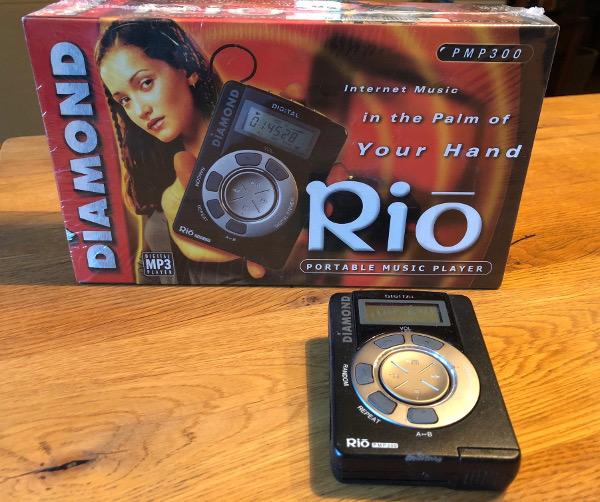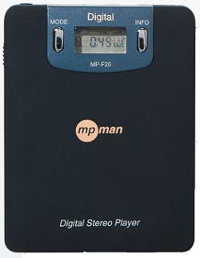Flashback 1998: A Compressed History of the Digital Music Player

A momentous occasion in the evolution of recorded music occurred 20 years ago when a California district court ruled to allow the sale of a curious new portable music player in the face of opposition from the Recording Industry Association of America (RIAA). Here’s a compressed history of the events surrounding the birth of the MP3 player.
 Which MP3 player came first? Technically, the Korean-made MPMan, which was unveiled in March, 1998, appeared first. But the MPMan was expensive, wasn't widely available, and it didn't work very well. Only a few hundred units were sold…
Which MP3 player came first? Technically, the Korean-made MPMan, which was unveiled in March, 1998, appeared first. But the MPMan was expensive, wasn't widely available, and it didn't work very well. Only a few hundred units were sold…
Announced in September, 1998, Diamond Multimedia's Rio PMP300, in contrast, cost $199.95, was easy to use, and was packaged with all the necessary cables and software. It also sold more than 400,000 units, making it the first commercially successful digital music player.
But the "which-was-first" debate is superfluous. It wasn't until a court ruling on October 26, 1998 making it legal to make and sell the Rio and subsequent portable digital music players that the record industry was pulled kicking and screaming into its own enormously profitable digital music-selling future.
The Backstory
Diamond Multimedia needed a brilliant idea. The San Jose-based company's core aftermarket graphics card business was slowly disintegrating as chip makers began to integrate graphics processors onto motherboards. Considering its young, PC nerd customer base, the nascent MP3 market seemed to be a ripe one to exploit.
 But how? The MP3 format, invented in the early 1990s by a team led by Karlheinz Brandenburg at Germany's Fraunhofer Institute, was still an infant, and the first Windows-based music player, Winamp, had only just been released. Diamond executive Ken Comstock admitted he "didn't even know how to spell MP3." But Diamond's audio product manager Todd Moore was quite familiar with Winamp, and he presented a plan for a portable MP3 digital audio player that he dubbed Loony Tunes.
But how? The MP3 format, invented in the early 1990s by a team led by Karlheinz Brandenburg at Germany's Fraunhofer Institute, was still an infant, and the first Windows-based music player, Winamp, had only just been released. Diamond executive Ken Comstock admitted he "didn't even know how to spell MP3." But Diamond's audio product manager Todd Moore was quite familiar with Winamp, and he presented a plan for a portable MP3 digital audio player that he dubbed Loony Tunes.
Moore’s idea was well received, but Comstock, multimedia division VP David Watkins, and everyone else at Diamond also worried that their small company would be beaten to the portable music player punch. Diamond had to act fast.
Scouring the market, they discovered the MPMan and multiple "crappy little reference designs" of several MPMan iterations, according to Moore, all using an MP3 decoder chip made by ESS Technology and "hung together by Band-Aids, rubber bands, and glue."
Using his Korean college chum network, Diamond CTO Hyuang Hwe Huh tracked down the company behind the MPMan: DigitalCast, a startup with 20 employees founded by a young engineer, Jung-ha Hwang. In the spring of 1998, Huh and Comstock jumped on plane and flew to Korea to meet with Hwang and MPMan's designers. In a hotel room in Seoul, they signed up DigitalCast to work for Diamond.
Fortunately, the Korean team recognized the shortcomings of its first MPMan versions and had renders of next-generation designs. Moore worked with Hwang and his team to finalize a hardware design, with Diamond engineers supplying the control and interface software. Intent on making the player a complete out-of-the-box solution, they then arranged for licensing of the MusicMatch ripping and Jukebox music database software, and of one hundred MP3 tracks from mostly unsigned acts. Marketing VP Ken Wirt worked with a branding company to come up with the Rio brand name, package design, and marketing and PR campaigns. The only thing missing: broad access to music.
Enter the RIAA
While on a press tour in New York, Comstock met with executives from Sony Music. But instead of hip music-industry types, the conference room was filled with stern-looking lawyers. When Comstock tried to tell them about how Diamond had this cool new digital music playing device, the lawyers interrupted. "No you don't."
"I got the sense — not that it was said, but implied — that they were going to try and sue us to stop us," Comstock recalled. "It was a very uncomfortable meeting."
The record industry not only wasn't sure how they were going sell digital music, they weren't even sure they wanted to. Selling CDs was a healthy, profitable business. They also didn't know how they were going to copy-protect songs “ripped” from CDs by consumers. What record labels knew for sure was that they didn't want a device that could digitally copy and move their music around for free.
Judgement Day
 Rio announced the PMP300 on September 15, 1998. Then, on October 9, the RIAA filed for a preliminary injunction in U.S. District Court for the Central District of California alleging that Rio violated the American Home Recording Act of 1992 (AHRA). On October 16, Judge Aubrey B. Collins issued a temporary restraining order enjoining Diamond from further manufacturing or distributing of the Rio.
Rio announced the PMP300 on September 15, 1998. Then, on October 9, the RIAA filed for a preliminary injunction in U.S. District Court for the Central District of California alleging that Rio violated the American Home Recording Act of 1992 (AHRA). On October 16, Judge Aubrey B. Collins issued a temporary restraining order enjoining Diamond from further manufacturing or distributing of the Rio.
During hearings, Diamond lawyers argued that Rio didn't violate the AHRA because it was akin to a Roach Motel. "The music checks in but it can't check out," Wirt summarized. Diamond also argued that the Rio offered other consumer benefits, particularly that music wouldn't skip unlike with sensitive portable CD players. According to Wirt, Judge Collins noted, "Yes, I can imagine using it while I am vacuuming."
On October 26, Judge Collins denied the injunction Rio announced the PMP300 on September 15, 1998, concluding that "because the Rio is capable of recording legitimate digital music, an injunction would deprive the public of a device with significant beneficial uses."
Within a week of Judge Collins' ruling, the Rio went on sale and was an immediate hit. "We made music more portable, more personal. You could listen to your music how you wanted, when you wanted," Watkins recalled. "That's what struck a chord with people. We couldn't build them fast enough."
Epilogue
The RIAA appealed Judge Collins' decision, but her ruling was upheld by the Ninth Circuit Court of Appeals on June 15, 1999.
Everyone at Diamond knew the Rio needed to be paired with a matching legal music store to succeed long-term. But with consumers essentially stealing music via the just-launched Napster and other mushrooming peer-to-peer services, the record labels were in no mood to license their libraries to Diamond or any other digital music player company. And Diamond wasn't big enough or powerful enough to convince them otherwise. "It took Steve Jobs to pull that off," Comstock freely admits.
The launch of Apple's iPod in October 2001 and the subsequent launch of iTunes in April, 2003 eventually doomed the Rio. "No question, we were the test case," Watkins observed. "It opened the door for everyone else."
Related:
Flashback 1998: Birth of the MP3 Player
Flashback 1999: Napster Is Born
Flashback 2003: Apple Launches iTunes Store
Flashback 2005: Apple Unveils the iPod nano
The Pohlmann Interview Sound&Vision’s Ken Pohlmann sees the future of recorded music in 1998 in a portable music player made by an unknown Korean company
- Log in or register to post comments

























































